Transplantation of Human Glial Progenitors to Immunodeficient Neonatal Mice with Amyotrophic Lateral Sclerosis (SOD1/rag2)
Abstract
1. Introduction
2. Materials and Methods
2.1. hGRPs
2.2. Immunocytochemistry
2.3. RT-qPCR
2.4. SOD1/rag2 Mice
2.5. Q-Cell® Transplantation
2.6. Experimental Design, Tissue and Data Collection
2.7. Magnetic Resonance Imaging
2.8. Nissl Staining and MN Counts
2.9. Immunohistochemistry
2.10. Western Blot (WB)
2.11. Statistical Analysis
3. Results
3.1. The molecular Identity of Q Cells
3.1.1. Immunocytochemical Analysis
3.1.2. RT-qPCR Analysis
3.2. Survival Analysis
3.3. MR Imaging of Degenerative Changes in the Brain Stem
3.4. Postmortem Analysis
3.4.1. Nissl Staining and Motoneuron Count
3.4.2. Comparison of Localization and Relative Level of Human msSOD1 between Q-Cell-Transplanted and Nontransplanted SOD1/Rag2 Mice
3.4.3. Detection of Human Cells in Transplanted SOD1/Rag2 Mice
4. Discussion
5. Conclusions
Author Contributions
Funding
Institutional Review Board Statement
Informed Consent Statement
Data Availability Statement
Acknowledgments
Conflicts of Interest
References
- Brown, R.H.; Al-Chalabi, A. Amyotrophic lateral sclerosis. N. Engl. J. Med. 2017, 377, 162–172. [Google Scholar] [CrossRef] [PubMed]
- Paré, B.; Lehmann, M.; Beaudin, M.; Nordström, U.; Saikali, S.; Julien, J.-P.; Gilthorpe, J.D.; Marklund, S.L.; Cashman, N.R.; Andersen, P.M.; et al. Misfolded SOD1 pathology in sporadic Amyotrophic Lateral Sclerosis. Sci. Rep. 2018, 8, 14223. [Google Scholar] [CrossRef] [PubMed]
- Komatsu, K.; Imamura, K.; Yamashita, H.; Julien, J.-P.; Takahashi, R.; Inoue, H. Overexpressed wild-type superoxide dismutase 1 exhibits amyotrophic lateral sclerosis-related misfolded conformation in induced pluripotent stem cell-derived spinal motor neurons. NeuroReport 2018, 29, 25–29. [Google Scholar] [CrossRef] [PubMed]
- Tokuda, E.; Takei, Y.-I.; Ohara, S.; Fujiwara, N.; Hozumi, I.; Furukawa, Y. Wild-type Cu/Zn-superoxide dismutase is misfolded in cerebrospinal fluid of sporadic amyotrophic lateral sclerosis. Mol. Neurodegener. 2019, 14, 42. [Google Scholar] [CrossRef]
- Medinas, D.B.; Rozas, P.; Traub, F.M.; Woehlbier, U.; Brown, R.H.; Bosco, D.; Hetz, C. Endoplasmic reticulum stress leads to accumulation of wild-type SOD1 aggregates associated with sporadic amyotrophic lateral sclerosis. Proc. Natl. Acad. Sci. USA 2018, 115, 8209–8214. [Google Scholar] [CrossRef]
- Willing, A.E.; Garbuzova-Davis, S.; Saporta, S.; Milliken, M.; Cahill, D.W.; Sanberg, P.R. hNT neurons delay onset of motor deficits in a model of amyotrophic lateral sclerosis. Brain Res. Bull. 2001, 56, 525–530. [Google Scholar] [CrossRef]
- Kim, H.; Kim, H.Y.; Choi, M.R.; Hwang, S.; Nam, K.-H.; Han, J.S.; Kim, K.S.; Yoon, H.S.; Kim, S.H. Dose-dependent efficacy of ALS-human mesenchymal stem cells transplantation into cisterna magna in SOD1-G93A ALS mice. Neurosci. Lett. 2010, 468, 190–194. [Google Scholar] [CrossRef]
- Mazzini, L.; Vercelli, A.; Ferrero, I.; Boido, M.; Cantello, R.; Fagioli, F. Transplantation of mesenchymal stem cells in ALS. In Progress in Brain Research; Elsevier B.V.: Amsterdam, The Netherlands, 2012; Volume 201, pp. 333–359. [Google Scholar]
- Mazzini, L.; Ferrero, I.; Luparello, V.; Rustichelli, D.; Gunetti, M.; Mareschi, K.; Testa, L.; Stecco, A.; Tarletti, R.; Miglioretti, M.; et al. Mesenchymal stem cell transplantation in amyotrophic lateral sclerosis: A Phase I clinical trial. Exp. Neurol. 2010, 223, 229–237. [Google Scholar] [CrossRef]
- Birger, A.; Ben-Dor, I.; Ottolenghi, M.; Turetsky, T.; Gil, Y.; Sweetat, S.; Perez, L.; Belzer, V.; Casden, N.; Steiner, D.; et al. Human iPSC-derived astrocytes from ALS patients with mutated C9ORF72 show increased oxidative stress and neurotoxicity. EBioMedicine 2019, 50, 274–289. [Google Scholar] [CrossRef]
- Yamanaka, K.; Chun, S.J.; Boillee, S.; Fujimori-Tonou, N.; Yamashita, H.; Gutmann, D.; Takahashi, R.; Misawa, H.; Cleveland, D.W. Astrocytes as determinants of disease progression in inherited amyotrophic lateral sclerosis. Nat. Neurosci. 2008, 11, 251–253. [Google Scholar] [CrossRef]
- Weichert, A.; Besemer, A.S.; Liebl, M.; Hellmann, N.; Koziollek-Drechsler, I.; Ip, P.; Decker, H.; Robertson, J.; Chakrabartty, A.; Behl, C.; et al. Wild-type Cu/Zn superoxide dismutase stabilizes mutant variants by heterodimerization. Neurobiol. Dis. 2014, 62, 479–488. [Google Scholar] [CrossRef] [PubMed]
- Lee, Y.; Morrison, B.M.; Li, Y.; Lengacher, S.; Farah, M.H.; Hoffman, P.N.; Liu, Y.; Tsingalia, A.; Jin, L.; Zhang, P.-W.; et al. Oligodendroglia metabolically support axons and contribute to neurodegeneration. Nature 2012, 487, 443–448. [Google Scholar] [CrossRef]
- Golubczyk, D.; Malysz-Cymborska, I.; Kalkowski, L.; Janowski, M.; Coates, J.R.; Wojtkiewicz, J.; Maksymowicz, W.; Walczak, P. The Role of Glia in Canine Degenerative Myelopathy: Relevance to Human Amyotrophic Lateral Sclerosis. Mol. Neurobiol. 2019, 56, 5740–5748. [Google Scholar] [CrossRef] [PubMed]
- Lepore, A.C.; Rauck, B.; Dejea, C.; Pardo, A.; Rao, M.S.; Rothstein, J.D.; Maragakis, N.J. Focal transplantation–based astrocyte replacement is neuroprotective in a model of motor neuron disease. Nat. Neurosci. 2008, 11, 1294–1301. [Google Scholar] [CrossRef] [PubMed]
- Lyczek, A.; Arnold, A.; Zhang, J.; Campanelli, J.T.; Janowski, M.; Bulte, J.W.; Walczak, P. Transplanted human glial-restricted progenitors can rescue the survival of dysmyelinated mice independent of the production of mature, compact myelin. Exp. Neurol. 2017, 291, 74–86. [Google Scholar] [CrossRef]
- Stanaszek, L.; Majchrzak, M.; Drela, K.; Rogujski, P.; Sanford, J.; Fiedorowicz, M.; Gewartowska, M.; Frontczak-Baniewicz, M.; Walczak, P.; Lukomska, B.; et al. Myelin-Independent Therapeutic Potential of Canine Glial-Restricted Progenitors Transplanted in Mouse Model of Dysmyelinating Disease. Cells 2021, 10, 2968. [Google Scholar] [CrossRef]
- Habisch, H.-J.; Janowski, M.; Binder, D.; Kuzma-Kozakiewicz, M.; Widmann, A.; Habich, A.; Schwalenstöcker, B.; Hermann, A.; Brenner, R.; Lukomska, B.; et al. Intrathecal application of neuroectodermally converted stem cells into a mouse model of ALS: Limited intraparenchymal migration and survival narrows therapeutic effects. J. Neural Transm. 2007, 114, 1395–1406. [Google Scholar] [CrossRef]
- Janowski, M.; Kuzma-Kozakiewicz, M.; Binder, D.; Habisch, H.-J.; Habich, A.; Lukomska, B.; Domanska-Janik, K.; Ludolph, A.C.; Storch, A. Neurotransplantation in mice: The concorde-like position ensures minimal cell leakage and widespread distribution of cells transplanted into the cisterna magna. Neurosci. Lett. 2008, 430, 169–174. [Google Scholar] [CrossRef]
- Majchrzak, M.; Drela, K.; Andrzejewska, A.; Rogujski, P.; Figurska, S.; Fiedorowicz, M.; Walczak, P.; Janowski, M.; Lukomska, B.; Stanaszek, L. SOD1/Rag2 Mice with Low Copy Number of SOD1 Gene as a New Long-Living Immunodeficient Model of ALS. Sci. Rep. 2019, 9, 799. [Google Scholar] [CrossRef]
- Sandrock, R.W.; Wheatley, W.; Levinthal, C.; Lawson, J.; Hashimoto, B.; Rao, M.; Campanelli, J.T. Isolation, characterization and preclinical development of human glial-restricted progenitor cells for treatment of neurological disorders. Regen. Med. 2010, 5, 381–394. [Google Scholar] [CrossRef]
- Chomczynski, P.; Sacchi, N. Single-step method of RNA isolation by acid guanidinium thiocyanate–phenol–chloroform extraction. Anal. Biochem. 1987, 162, 156–159. [Google Scholar] [CrossRef]
- Zalfa, C.; Nodari, L.R.; Vacchi, E.; Gelati, M.; Profico, D.; Boido, M.; Binda, E.; De Filippis, L.; Copetti, M.; Garlatti, V.; et al. Transplantation of clinical-grade human neural stem cells reduces neuroinflammation, prolongs survival and delays disease progression in the SOD1 rats. Cell Death Dis. 2019, 10, 345. [Google Scholar] [CrossRef] [PubMed]
- Nakanishi, M.; Watanabe, Y.; Honda, N.; Une, M.; Kazuki, K.; Kazuki, Y.; Terashima, T.; Katagi, M.; Nakashima, K.; Hanajima, R. Dynamics of host and graft after cell sheet transplantation: Basic study for the application of amyotrophic lateral sclerosis. Brain Res. 2019, 1724, 146444. [Google Scholar] [CrossRef] [PubMed]
- Bursch, F.; Rath, K.J.; Sarikidi, A.; Böselt, S.; Kefalakes, E.; Osmanovic, A.; Thau-Habermann, N.; Klöß, S.; Köhl, U.; Petri, S. Analysis of the therapeutic potential of different administration routes and frequencies of human mesenchymal stromal cells in the SOD1 G93A mouse model of amyotrophic lateral sclerosis. J. Tissue Eng. Regen. Med. 2019, 13, 649–663. [Google Scholar] [CrossRef]
- Garbuzova-Davis, S.; Haller, E.; Navarro, S.; Besong, T.E.; Boccio, K.J.; Hailu, S.; Khatib, M.; Sanberg, P.R.; Appel, S.H.; Borlongan, C.V. Transplantation of human bone marrow stem cells into symptomatic ALS mice enhances structural and functional blood-spinal cord barrier repair. Exp. Neurol. 2018, 310, 33–47. [Google Scholar] [CrossRef]
- Glass, J.D.; Hertzberg, V.S.; Boulis, N.M.; Riley, J.; Federici, T.; Polak, M.; Bordeau, J.; Fournier, C.; Johe, K.; Hazel, T.; et al. Transplantation of spinal cord–derived neural stem cells for ALS: Analysis of phase 1 and 2 trials. Neurology 2016, 87, 392–400. [Google Scholar] [CrossRef]
- Barczewska, M.; Maksymowicz, S.; Zdolińska-Malinowska, I.; Siwek, T.; Grudniak, M. Umbilical Cord Mesenchymal Stem Cells in Amyotrophic Lateral Sclerosis: An Original Study. Stem Cell Rev. Rep. 2020, 16, 922–932. [Google Scholar] [CrossRef]
- Berry, J.D.; Cudkowicz, M.E.; Windebank, A.J.; Staff, N.P.; Owegi, M.; Nicholson, K.; McKenna-Yasek, D.; Levy, Y.S.; Abramov, N.; Kaspi, H.; et al. NurOwn, phase 2, randomized, clinical trial in patients with ALS: Safety, clinical, and bi-omarker results. Neurology 2019, 93, e2294–e2305. [Google Scholar] [CrossRef]
- Baumert, B.; Sobuś, A.; Gołąb-Janowska, M.; Paczkowska, E.; Łuczkowska, K.; Rogińska, D.; Zawiślak, A.; Milczarek, S.; Osękowska, B.; Pawlukowska, W.; et al. Repeated Application of Autologous Bone Marrow-Derived Lineage-Negative Stem/Progenitor Cells—Focus on Immunological Pathways in Patients with ALS. Cells 2020, 9, 1822. [Google Scholar] [CrossRef]
- Duma, C.; Kopyov, O.; Kopyov, A.; Berman, M.; Lander, E.; Elam, M.; Arata, M.; Weiland, D.; Cannell, R.; Caraway, C.; et al. Human intracerebroventricular (ICV) injection of autologous, non-engineered, adipose-derived stromal vascular fraction (ADSVF) for neurodegenerative disorders: Results of a 3-year phase 1 study of 113 injections in 31 patients. Mol. Biol. Rep. 2019, 46, 5257–5272. [Google Scholar] [CrossRef]
- Goutman, S.A.; Savelieff, M.; Sakowski, S.A.; Feldman, E.L. Stem cell treatments for amyotrophic lateral sclerosis: A critical overview of early phase trials. Expert Opin. Investig. Drugs 2019, 28, 525–543. [Google Scholar] [CrossRef] [PubMed]
- Srivastava, A.; Bulte, C.A.; Shats, I.; Walczak, P.; Bulte, J.W. Co-transplantation of syngeneic mesenchymal stem cells improves survival of allogeneic glial-restricted precursors in mouse brain. Exp. Neurol. 2015, 275, 154–161. [Google Scholar] [CrossRef] [PubMed]
- Srivastava, A.; Gross, S.K.; Almad, A.A.; Bulte, C.A.; Maragakis, N.J.; Bulte, J.W. Serial in vivo imaging of transplanted allogeneic neural stem cell survival in a mouse model of amyotrophic lateral sclerosis. Exp. Neurol. 2016, 289, 96–102. [Google Scholar] [CrossRef]
- Jablonska, A.; Drela, K.; Wojcik-Stanaszek, L.; Janowski, M.; Zalewska, T.; Lukomska, B. Short-Lived Human Umbilical Cord-Blood-Derived Neural Stem Cells Influence the Endogenous Secretome and Increase the Number of Endogenous Neural Progenitors in a Rat Model of Lacunar Stroke. Mol. Neurobiol. 2015, 53, 6413–6425. [Google Scholar] [CrossRef]
- Muhammad, G.; Xu, J.; Bulte, J.W.M.; Jablonska, A.; Walczak, P.; Janowski, M. Transplanted adipose-derived stem cells can be short-lived yet accelerate healing of acid-burn skin wounds: A multimodal imaging study. Sci. Rep. 2017, 7, 4644. [Google Scholar] [CrossRef] [PubMed]
- Kim, H.; Walczak, P.; Kerr, C.; Galpoththawela, C.; Gilad, A.A.; Muja, N.; Bulte, J.W. Immunomodulation by Transplanted Human Embryonic Stem Cell-Derived Oligodendroglial Progenitors in Experimental Autoimmune Encephalomyelitis. Stem Cells 2012, 30, 2820–2829. [Google Scholar] [CrossRef][Green Version]
- Kim, H.; Walczak, P.; Muja, N.; Campanelli, J.T.; Bulte, J.W. ICV-transplanted human glial precursor cells are short-lived yet exert immunomodulatory effects in mice with EAE. Glia 2012, 60, 1117–1129. [Google Scholar] [CrossRef]
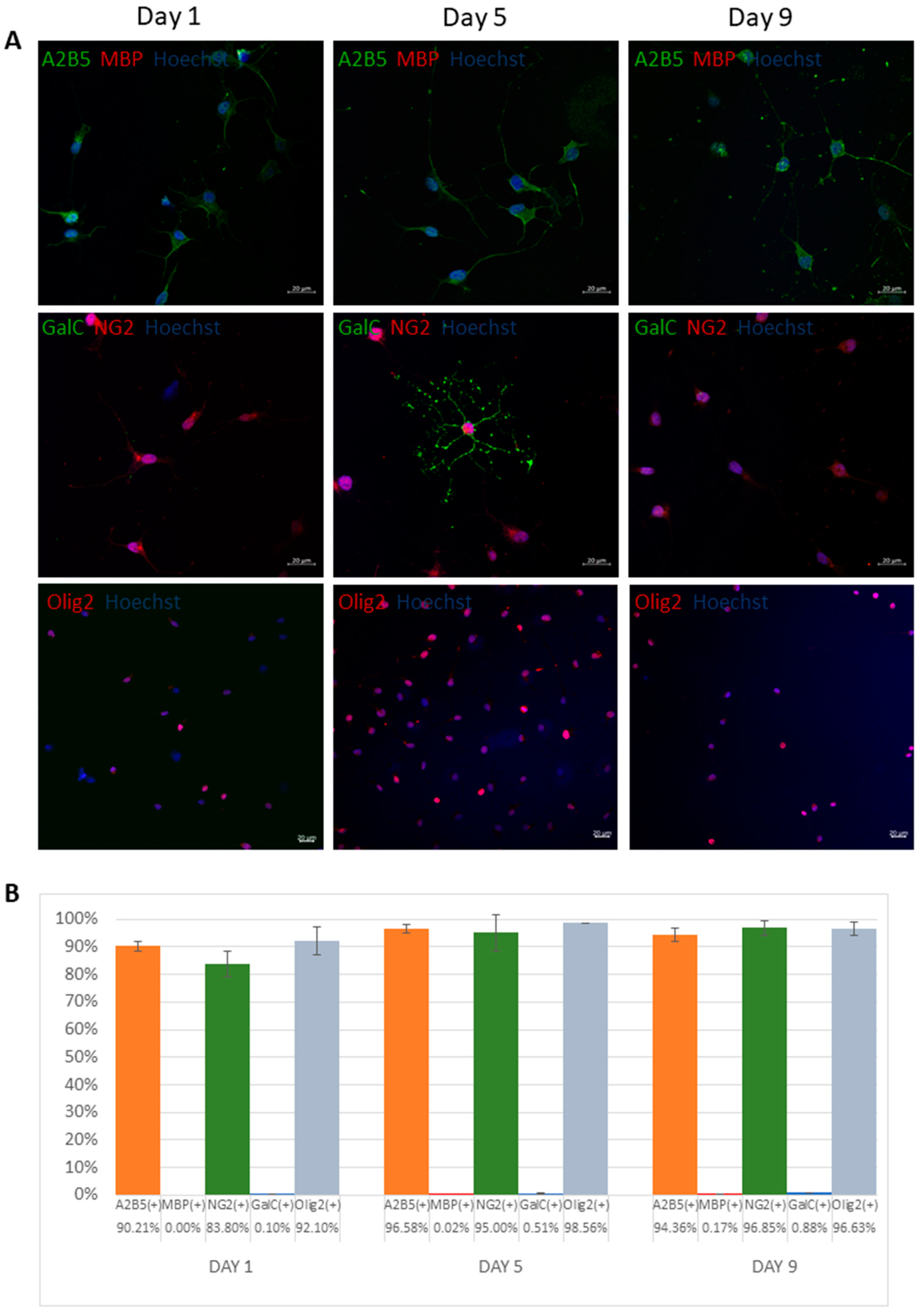

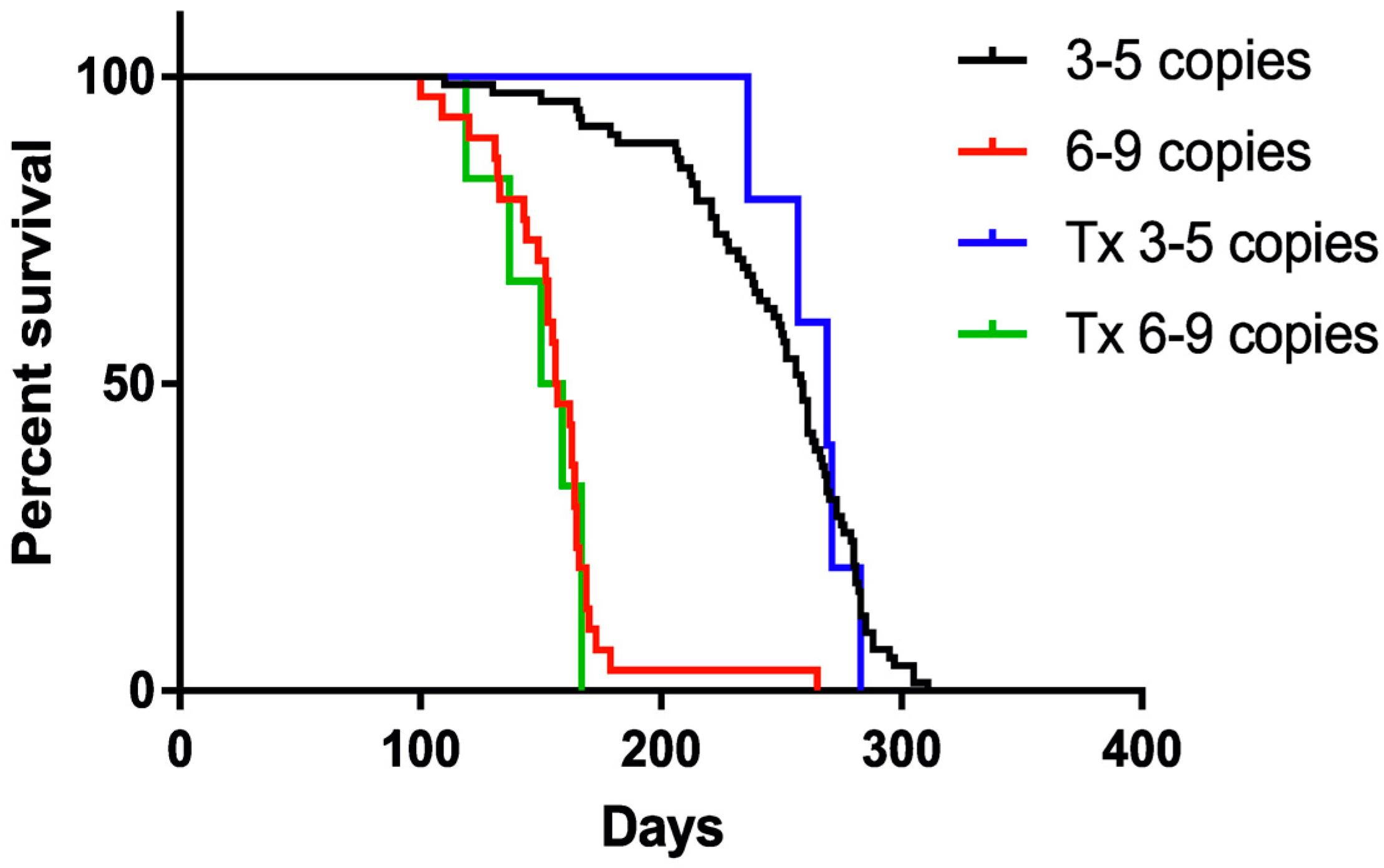
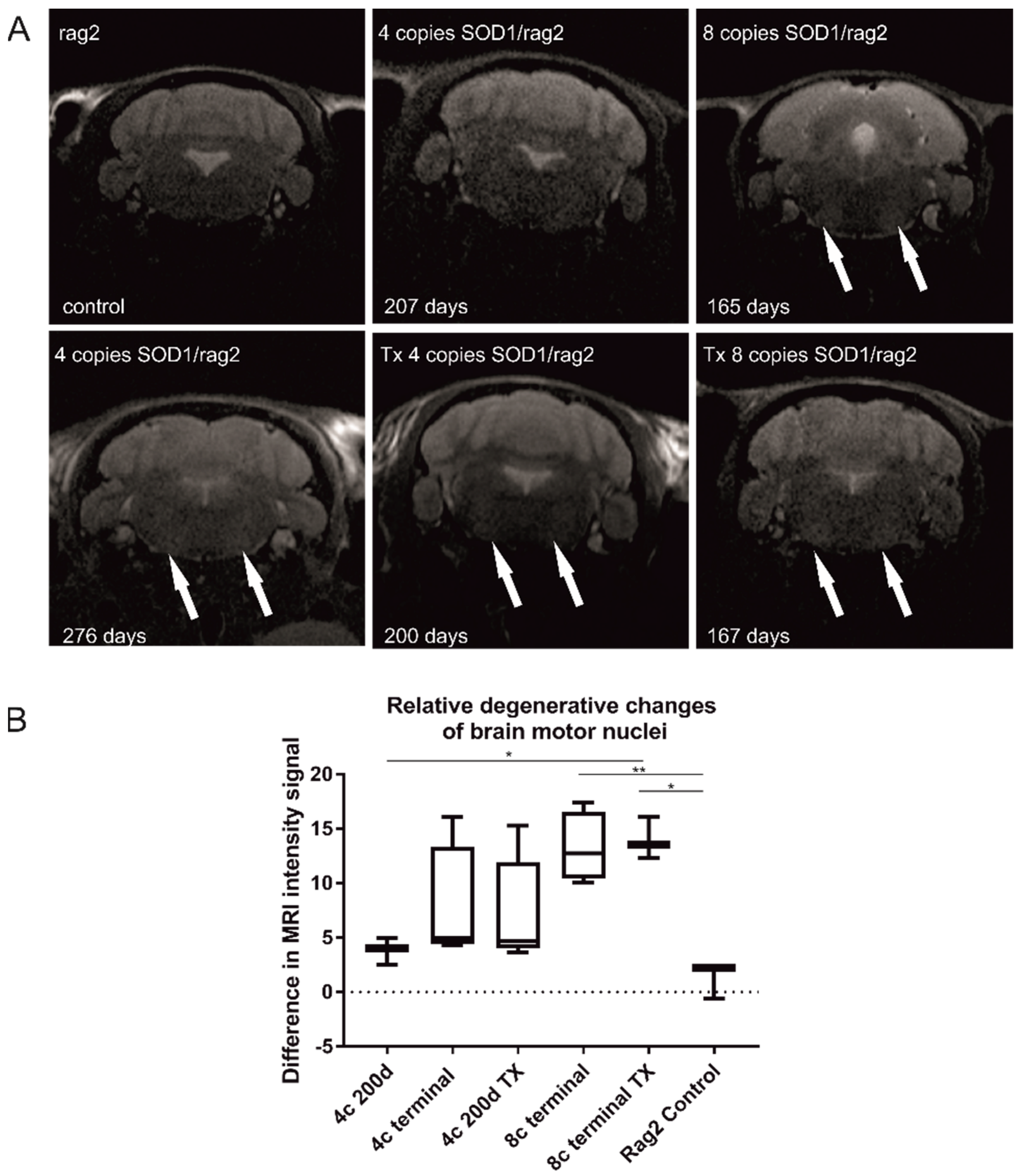
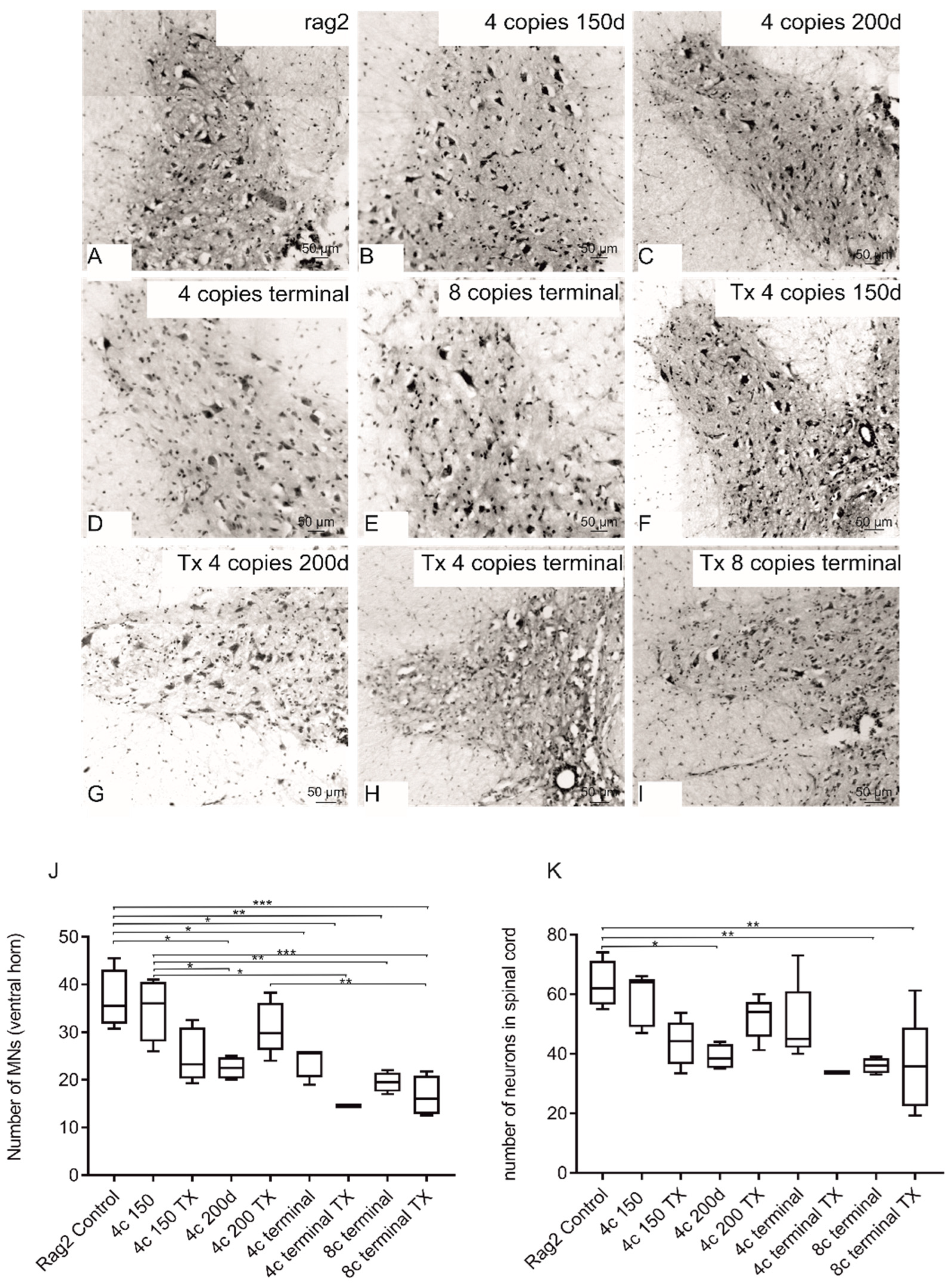

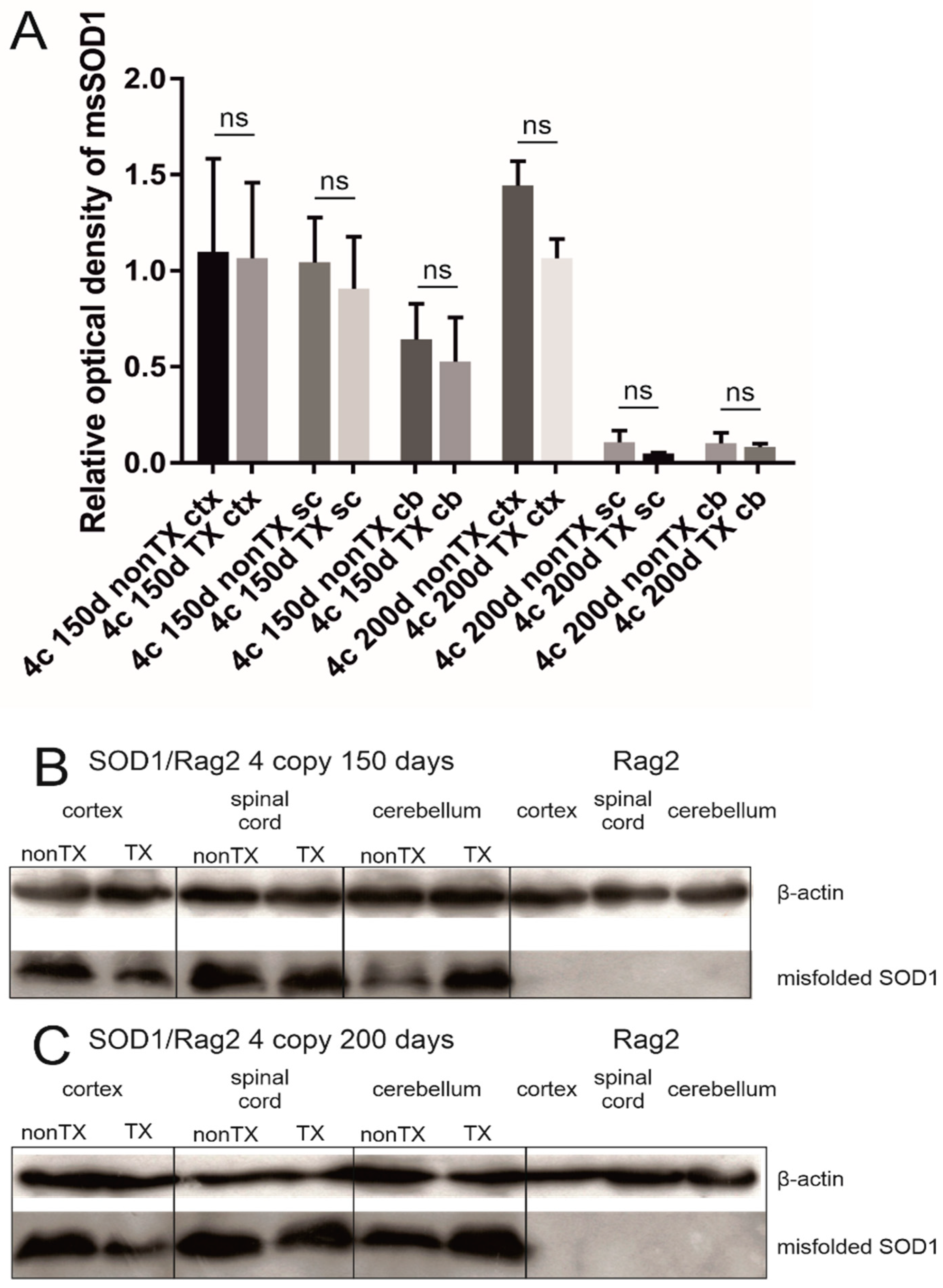
| Gene Name | Primer Sequence |
|---|---|
| TGFβ (NM_000660) | Forward: GTACCTGAACCCGTGTTGCT Reverse: TAGTGAACCCGTTGATGTCCA |
| GDNF (NM_000514.4) | Forward: CCAACCCAGAGAATTCCAGA Reverse: AGCCGCTGCAGTACCTAAAA |
| EGF (NM_001178130.3) | Forward: GACTTGGGAGCCTGAGCAGAA Reverse: CATGCACAAGTGTGACTGGAGGT |
| BDNF (NM_170734.4) | Forward: CAGGGGCATAGACAAAAG Reverse: CTTCCCCTTTTAATGGTC |
| Ng2 (NM_001897.5) | Forward: GAGCCCAGGCACGAAAAATG Reverse: GTATGTTTGGCCCCTCCGAA |
| GalC (NM_001201401.2) | Forward: TCGTTTCCTCAGCCTCATCTC Reverse: CTCCCCTCCTTCCACACATAAG |
| Olig2 (NM_005806.4) | Forward: CGACTCATCTTTCCTTCTCTAA Reverse: CGCACTTACCTCATCATTG |
| GAPDH | Forward: ATGGGGAAGGTGAAGGTCG Reverse: GGGGTCATTGATGGCAACAATA |
| SOD1/rag2 Tx 4-Copies | SOD1/rag2 Tx 8-Copies | SOD1/rag2 No Tx 4-Copies | SOD1/rag2 No Tx 8-Copies | Rag2 no Tx | ||
|---|---|---|---|---|---|---|
| Survival | n = 5 | n = 6 | n = 74 | n = 30 | - | |
| IHC | 150 days | n = 5 | n = 4 | n = 7 | n = 4 (terminal) | n = 3 (126 days) |
| 200 days | n = 6 | - | n = 3 | - | ||
| >220 days | - | - | n = 5 | - | ||
| Nissl staining | 150 days | n = 4 | n = 4 | n = 5 | n = 4 (terminal) | n = 4 |
| 200 days | n = 6 | - | n = 4 | - | ||
| >220 days | n = 1 | - | n = 5 | - | ||
| WB | 150 days | n = 5 | - | n = 5 | - | n = 5 (28.5 weeks) |
| 200 days | n = 5 | - | n = 5 | - | ||
| MRI | n = 5 | n = 3 | n = 7 | n = 5 | n = 3 | |
Publisher’s Note: MDPI stays neutral with regard to jurisdictional claims in published maps and institutional affiliations. |
© 2022 by the authors. Licensee MDPI, Basel, Switzerland. This article is an open access article distributed under the terms and conditions of the Creative Commons Attribution (CC BY) license (https://creativecommons.org/licenses/by/4.0/).
Share and Cite
Stanaszek, L.; Rogujski, P.; Drela, K.; Fiedorowicz, M.; Walczak, P.; Lukomska, B.; Janowski, M. Transplantation of Human Glial Progenitors to Immunodeficient Neonatal Mice with Amyotrophic Lateral Sclerosis (SOD1/rag2). Antioxidants 2022, 11, 1050. https://doi.org/10.3390/antiox11061050
Stanaszek L, Rogujski P, Drela K, Fiedorowicz M, Walczak P, Lukomska B, Janowski M. Transplantation of Human Glial Progenitors to Immunodeficient Neonatal Mice with Amyotrophic Lateral Sclerosis (SOD1/rag2). Antioxidants. 2022; 11(6):1050. https://doi.org/10.3390/antiox11061050
Chicago/Turabian StyleStanaszek, Luiza, Piotr Rogujski, Katarzyna Drela, Michal Fiedorowicz, Piotr Walczak, Barbara Lukomska, and Miroslaw Janowski. 2022. "Transplantation of Human Glial Progenitors to Immunodeficient Neonatal Mice with Amyotrophic Lateral Sclerosis (SOD1/rag2)" Antioxidants 11, no. 6: 1050. https://doi.org/10.3390/antiox11061050
APA StyleStanaszek, L., Rogujski, P., Drela, K., Fiedorowicz, M., Walczak, P., Lukomska, B., & Janowski, M. (2022). Transplantation of Human Glial Progenitors to Immunodeficient Neonatal Mice with Amyotrophic Lateral Sclerosis (SOD1/rag2). Antioxidants, 11(6), 1050. https://doi.org/10.3390/antiox11061050









